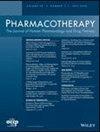对开始接受英夫利西单抗维持治疗的成年克罗恩病患者采用新型精确用药指导策略的模拟成本效益
IF 2.9
3区 医学
Q2 PHARMACOLOGY & PHARMACY
引用次数: 0
摘要
背景克罗恩病(CD)患者对生物制剂失去反应后,生活质量(QoL)下降,住院费用高昂。精确指导给药(PGD)提供了全面的药代动力学(PK)资料,可实现生物制剂给药的个性化。我们分析了英夫利西单抗(IFX)PGD相对于其他两种剂量加强策略(DIS)的成本效益。方法我们为对 IFX 诱导治疗有临床反应的 CD 患者建立了一个混合(马尔可夫和决策树)模型。该分析从美国支付方的角度出发,基础病例的时间跨度为 5 年,周期长度为 4 周。有三种 IFX 给药比较方案:PGD;基于症状、炎症指标和 IFX 谷浓度的剂量强化(DIS1);以及仅基于症状的剂量强化(DIS2)。IFX治疗失败的患者开始使用乌司替珠单抗,然后是维多珠单抗和常规疗法。IFX的转归概率是根据真实世界的临床PK数据和介入性临床试验患者水平数据估算得出的。所有其他过渡概率均来自已发表的随机临床试验和成本效益分析。效用值来源于之前的健康技术评估。直接成本包括生物制剂的购买和输注、手术和程序、常规治疗以及实验室检测。主要结果是增量成本效益比(ICER)。通过单向敏感性分析、情景分析和概率敏感性分析(PSA)对结果的稳健性进行了评估。结果PGD是具有成本效益的IFX给药策略,相对于DIS1,每质量调整生命年(QALY)的ICER为122,932美元,在DIS2中占优势。PGD在5年内需要使用新生物制剂的患者比例最低(1.1%)(DIS1和DIS2分别为8.9%和74.4%)。单向敏感性分析表明,PGD 的成本效益对 IFX 剂量之间的间隔时间最为敏感。PSA表明,联合参数的不确定性对某些结果有一定的影响。结论PGD通过维持缓解和避免IFX失效,为临床和QoL带来了益处;在保守假设下,PGD最具成本效益。本文章由计算机程序翻译,如有差异,请以英文原文为准。
Simulated cost‐effectiveness of a novel precision‐guided dosing strategy in adult patients with Crohn's disease initiating infliximab maintenance therapy
BackgroundPatients with Crohn's disease (CD) who lose response to biologics experience reduced quality of life (QoL) and costly hospitalizations. Precision‐guided dosing (PGD) provides a comprehensive pharmacokinetic (PK) profile that allows for biologic dosing to be personalized. We analyzed the cost‐effectiveness of infliximab (IFX) PGD relative to two other dose intensification strategies (DIS).MethodsWe developed a hybrid (Markov and decision tree) model of patients with CD who had a clinical response to IFX induction. The analysis had a US payer perspective, a base case time horizon of 5 years, and a 4‐week cycle length. There were three IFX dosing comparators: PGD; dose intensification based on symptoms, inflammatory markers, and trough IFX concentration (DIS1); and dose intensification based on symptoms alone (DIS2). Patients that failed IFX initiated ustekinumab, followed by vedolizumab, and conventional therapy. Transition probabilities for IFX were estimated from real‐world clinical PK data and interventional clinical trial patient‐level data. All other transition probabilities were derived from published randomized clinical trials and cost‐effectiveness analyses. Utility values were sourced from previous health technology assessments. Direct costs included biologic acquisition and infusion, surgeries and procedures, conventional therapy, and lab testing. The primary outcomes were incremental cost‐effectiveness ratios (ICERs). The robustness of results was assessed via one‐way sensitivity, scenario, and probabilistic sensitivity analyses (PSA).ResultsPGD was the cost‐effective IFX dosing strategy with an ICER of 122,932 $ per quality‐adjusted life year (QALY) relative to DIS1 and dominating DIS2. PGD had the lowest percentage (1.1%) of patients requiring a new biologic through 5 years (8.9% and 74.4% for DIS1 and DIS2, respectively). One‐way sensitivity analysis demonstrated that the cost‐effectiveness of PGD was most sensitive to the time between IFX doses. PSA demonstrated that joint parameter uncertainty had moderate impact on some results.ConclusionsPGD provides clinical and QoL benefits by maintaining remission and avoiding IFX failure; it is the most cost‐effective under conservative assumptions.
求助全文
通过发布文献求助,成功后即可免费获取论文全文。
去求助
来源期刊

Pharmacotherapy
医学-药学
CiteScore
7.80
自引率
2.40%
发文量
93
审稿时长
4-8 weeks
期刊介绍:
Pharmacotherapy is devoted to publication of original research articles on all aspects of human pharmacology and review articles on drugs and drug therapy. The Editors and Editorial Board invite original research reports on pharmacokinetic, bioavailability, and drug interaction studies, clinical trials, investigations of specific pharmacological properties of drugs, and related topics.
 求助内容:
求助内容: 应助结果提醒方式:
应助结果提醒方式:


